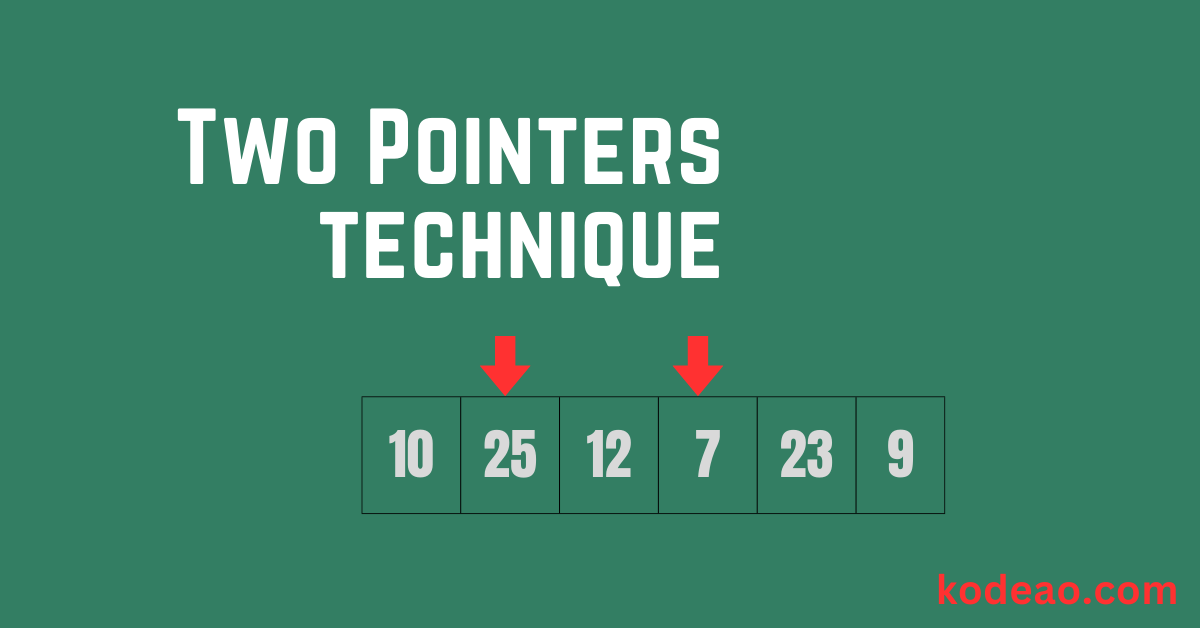In this article, we will explore the Two Pointer pattern in detail. We’ll discuss what it is, when to use it, and go through some classic examples to illustrate how powerful it can be.
What is the Two Pointer Technique in Coding?
The Two Pointer technique is a pattern where two pointers (or indices) are used to traverse a data structure, typically an array or a string, from different directions. The goal is to leverage these two pointers to solve problems that involve comparing elements at different positions in the structure.
The two pointers can move toward each other, away from each other, or in the same direction, depending on the problem. This pattern is particularly useful when dealing with problems such as:
- Finding pairs in a sorted array.
- Partitioning an array.
- Detecting duplicates.
- Merging two sorted arrays or linked lists.
If you need to compare or process elements in a sequence with each other, the Two Pointer technique is likely a strong candidate for a solution.
Types of Two Pointer Approaches
Here are three common types of Two Pointer approaches:
- (1).Opposite Direction Pointers: Start with two pointers at either end of a sequence and move them towards each other. This is useful for problems like determining if an array is a palindrome or finding a pair of elements that meet a certain criteria.
- (2).Same Direction Pointers: Begin with both pointers at the same point and move them in the same direction. This is often used in sliding window problems, where the goal is to find the longest or shortest subarray that meets certain conditions.
- (3).Fixed and Moving Pointers: One pointer is fixed at a certain position while the other moves through the data structure to compare or check conditions.
Examples of the Two Pointer Pattern
Let’s explore two classic examples demonstrating how the Two Pointer technique can be applied to solve common problems.
Example 1: Finding a Pair with a Given Sum in a Sorted Array
Problem Statement: Given a sorted array of integers, find two numbers that add up to a target sum. Return the indices of the two numbers.
Solution:
Since the array is sorted, we can use the Two Pointer technique effectively. We will initialize one pointer at the beginning of the array (left) and another at the end (right). Then, we check the sum of the elements at these two pointers:
- If the sum is equal to the target, we’ve found our pair.
- If the sum is less than the target, increment the
leftpointer to increase the sum. - If the sum is greater than the target, decrement the
rightpointer to decrease the sum.
Here is the Java implementation:
public class TwoPointerExample {
public static int[] findPairWithSum(int[] arr, int target) {
int left = 0, right = arr.length - 1;
while (left < right) {
int currentSum = arr[left] + arr[right];
if (currentSum == target) {
return new int[]{left, right}; // Return indices of the pair
} else if (currentSum < target) {
left++; // Move left pointer to the right
} else {
right--; // Move right pointer to the left
}
}
return new int[]{}; // No pair found
}
public static void main(String[] args) {
int[] arr = {1, 2, 3, 4, 6};
int target = 6;
int[] result = findPairWithSum(arr, target);
if (result.length > 0) {
System.out.println("Pair found at indices: " + result[0] + " and " + result[1]);
} else {
System.out.println("No pair found.");
}
}
}
Example 2: Checking if a String is a Palindrome
Problem Statement: Given a string, determine if it reads the same backward as forward.
Solution:
For this problem, we use two pointers: one starting at the beginning of the string (left) and the other at the end (right). We compare the characters at these positions:
- If they are the same, move both pointers towards the center.
- If they are different, the string is not a palindrome.
Here is the Java implementation:
public class PalindromeChecker {
public static boolean isPalindrome(String s) {
int left = 0, right = s.length() - 1;
while (left < right) {
if (s.charAt(left) != s.charAt(right)) {
return false; // Characters don't match, not a palindrome
}
left++;
right--;
}
return true; // All characters match, it's a palindrome
}
public static void main(String[] args) {
String input = "racecar";
boolean result = isPalindrome(input);
if (result) {
System.out.println("The string \"" + input + "\" is a palindrome.");
} else {
System.out.println("The string \"" + input + "\" is not a palindrome.");
}
}
}
Why Use the Two Pointer Pattern?
- Efficiency: The Two Pointer pattern often reduces the need for nested loops, lowering the time complexity from O(n^2) to O(n).
- Simplicity: It typically leads to cleaner, more readable code.
- Versatility: This pattern can be adapted for a variety of problems, particularly those involving sequences, sorting, and searching.
Conclusion
The Two Pointer coding pattern is a powerful technique that every programmer should master. Its efficiency and simplicity make it ideal for a wide range of problems, from simple tasks like checking for palindromes to more complex challenges like finding pairs in sorted arrays. By practicing this pattern and understanding its applications, you can significantly enhance your problem-solving skills and performance in coding interviews.
For more detailed information on the Two Pointer technique, you can refer to LeetCode.
So, next time you encounter a problem involving arrays or strings, ask yourself if the Two Pointer technique might be the perfect fit. Happy coding!

